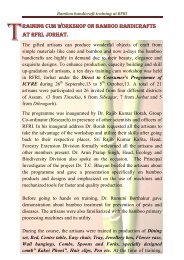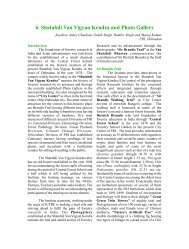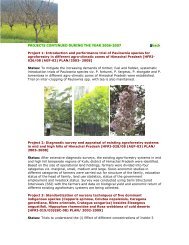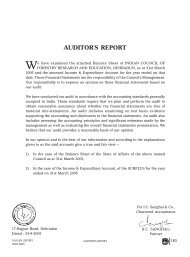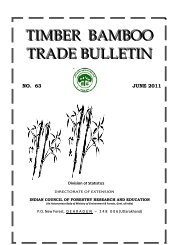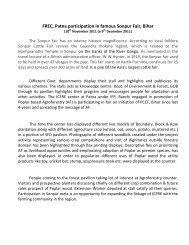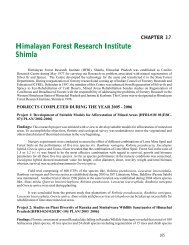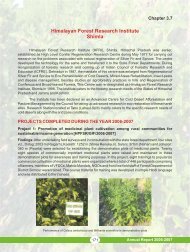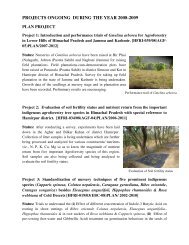Himalayan Forest Research Institute, Shimla - ICFRE
Himalayan Forest Research Institute, Shimla - ICFRE
Himalayan Forest Research Institute, Shimla - ICFRE
You also want an ePaper? Increase the reach of your titles
YUMPU automatically turns print PDFs into web optimized ePapers that Google loves.
were 9, 23 & 122 with dominance of Acer acuminatum, Rhododendron campanulatum and<br />
Polygonum polystachya respectively. In Shone Khad, number of trees, shrubs and herbs species<br />
were 11, 23 & 115 with dominance of Hippophae salicifolia, Juniperus indica and Rumex<br />
nepalensis respectively. In Hitch Pawang, number of trees, shrubs and herbs species were 3,<br />
29 & 103 with dominance of Pinus wallichiana, Lonicera parvifolia and Polygonum polystachya<br />
respectively. In Murti Panag, total number of tree, shrub and herb species were 7, 18 & 97<br />
with the dominance of Betula utilis, Berberis jaeschkeana and Potentilla atrosanguinea respectively.<br />
Rhododendron lepidotum Hippophae tibetana<br />
In Rani Kanda to Tumer Nala, the number of trees, shrubs and herbs species were 1, 11 &<br />
74 with dominance of Betula utilis, Rhododendron anthopogon and Polygonum polyatachya<br />
respectively. In Rani Kanda to Jarrya top, the number of trees, shrubs and herbs species were<br />
1, 8 & 98 with dominance of Betula utilis, Juniperus indica and Thymus linearis respectively. In<br />
Rasrang area, the number of trees, shrubs and herbs species were 13, 25 & 70 with dominance<br />
of Cedrus deodara, Abelia triflora and Rumex nepalensis respectively. Whereas, in Hurba area,<br />
the number of trees, shrubs and herbs species were 9, 25 & 73 with dominance of Betula utilis,<br />
Juniperus communis and Caltha palustris respectively. In Shingan area, the number of trees, shrubs<br />
and herbs species were 13, 26 & 95 with the dominance of Betula utilis, Rhododendron<br />
anthopogon and Thymus linearis respectively. Three species of Rhododendron viz., Rhododendron<br />
companulatum, R. anthopogon, and R. lepidotum were also recorded from the sanctuary. The<br />
distribution pattern of plant species was mostly contiguous in all the studied areas. The<br />
population structure of various tree species occurring in different areas of the sanctuary was<br />
estimated and recognized three patterns of population structure. Out of 105 medicinal plant<br />
species recorded from the various areas, 27 plant species fall in the category of threatened plants.<br />
Conducted ethnobotanical studies in Rakchham, Chitkul, Batseri, Themgarang, Boningsaring<br />
villages and documented 50 plant species used for various purposes.<br />
Project 3: Inventorization, documentation and to evolve site specific management strategies<br />
for the conservation of sacred groves of Kullu valley in Himachal Pradesh [GBPI/IERP/<br />
04-05/18/865/2005-08]<br />
Findings: A total of 33 sacred groves were inventorized in the Kullu valley and these sacred<br />
groves were found rich in plant biodiversity. A total of 224 plant species were recorded. The<br />
sacred groves serve as storehouse of medicinal plants. During the study, ethnobotanical<br />
information on 69 plant species were also documented. Deodar (Cedrus deodara) was recorded<br />
as the dominant tree species in most of the sacred groves. However, the number of deodar<br />
trees varied among the sacred groves. A pamphlet on “Dev van Ek Prachin Dhrohar” was<br />
<strong>ICFRE</strong><br />
ANNUAL REPORT 2008-09<br />
207




